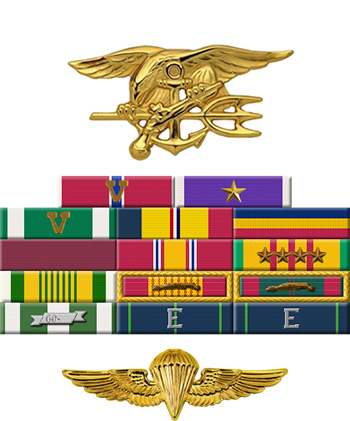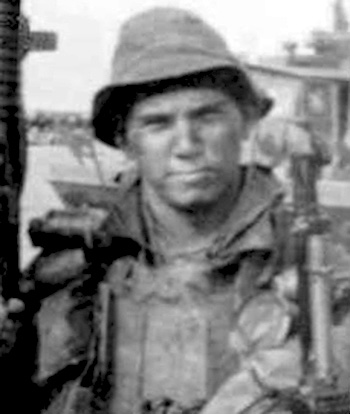James Riter was born on May 30, 1949, in Mansfield, Ohio. He enlisted in the U.S. Navy on September 21, 1967, and went on active duty to begin basic training on January 8, 1968. Riter completed basic training at NTC San Diego, California, in March 1968, and then attended Basic Underwater Demolition/SEAL training with Class 047 at NAB Coronado, California, from March to November 1968. His first assignment was with Underwater Demolition Team THIRTEEN (UDT-13) at NAB Coronado from November 1968 to April 1969, followed by service with SEAL Team ONE at NAB Coronado from April to October 1969. PO3 Riter deployed with his Team to Southeast Asia from October 1969 to April 1970, and again from October 1970 until he was killed in action in South Vietnam on December 20, 1970. James Riter was buried at Resthaven Park West Cemetery in Glendale, Arizona.
His Bronze Star Medal w/Valor Citation reads:
For meritorious service while serving with friendly foreign forces engaged in armed conflict against the North Vietnamese and Viet Cong communist aggressors in the Republic of Vietnam from October 1969 to April 1970. While serving as automatic weapons man for United States Naval SEAL Team One, Detachment Golf, Alfa Platoon, Petty Officer RITER participated in forty combat operations in the Viet Cong dominated areas of the lower Ca Mau peninsula. His personal courage and professional ability were instrumental in allowing his platoon to inflict severe casualties upon the enemy without sustaining a serious friendly casualty. On 27 February 1970, his patrol was tasked with the mission of interdicting Viet Cong cadre on a reported travel route. After inserting deep into enemy controlled territory and establishing an interdiction site along a canal crossing, he assumed his position as left flank security. Suddenly, a sampan with two Viet Cong aboard entered the site. After hailing the sampan, the patrol took the enemy under fire when they attempted to resist. Petty Officer RITER immediately entered the swiftly flowing water to retrieve the sampan. Continuing to expose himself while unarmed, he swam to the opposite bank of the canal to see if both the enemy had been killed. As a result of his actions, important enemy documents that might otherwise have been lost were recovered. His personal courage, professionalism and sense of responsibility were in keeping with the highest traditions of the United States Naval Service.
The Combat Distinguishing Device is authorized.
|



